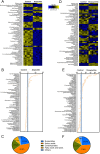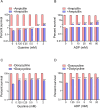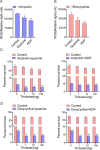Metabolomics analysis of the lactobacillus plantarum ATCC 14917 response to antibiotic stress
- PMID: 38943061
- PMCID: PMC11212188
- DOI: 10.1186/s12866-024-03385-3
Metabolomics analysis of the lactobacillus plantarum ATCC 14917 response to antibiotic stress
Abstract
Background: Lactobacillus plantarum has been found to play a significant role in maintaining the balance of intestinal flora in the human gut. However, it is sensitive to commonly used antibiotics and is often incidentally killed during treatment. We attempted to identify a means to protect L. plantarum ATCC14917 from the metabolic changes caused by two commonly used antibiotics, ampicillin, and doxycycline. We examined the metabolic changes under ampicillin and doxycycline treatment and assessed the protective effects of adding key exogenous metabolites.
Results: Using metabolomics, we found that under the stress of ampicillin or doxycycline, L. plantarum ATCC14917 exhibited reduced metabolic activity, with purine metabolism a key metabolic pathway involved in this change. We then screened the key biomarkers in this metabolic pathway, guanine and adenosine diphosphate (ADP). The exogenous addition of each of these two metabolites significantly reduced the lethality of ampicillin and doxycycline on L. plantarum ATCC14917. Because purine metabolism is closely related to the production of reactive oxygen species (ROS), the results showed that the addition of guanine or ADP reduced intracellular ROS levels in L. plantarum ATCC14917. Moreover, the killing effects of ampicillin and doxycycline on L. plantarum ATCC14917 were restored by the addition of a ROS accelerator in the presence of guanine or ADP.
Conclusions: The metabolic changes of L. plantarum ATCC14917 under antibiotic treatments were determined. Moreover, the metabolome information that was elucidated can be used to help L. plantarum cope with adverse stress, which will help probiotics become less vulnerable to antibiotics during clinical treatment.
Keywords: Lactobacillus plantarum ATCC14917; Antibiotics; Metabolomics; Probiotic protection.
© 2024. The Author(s).
Conflict of interest statement
The authors declare no competing interests.
Figures





Similar articles
-
Whole-genome sequencing reveals the mechanisms for evolution of streptomycin resistance in Lactobacillus plantarum.J Dairy Sci. 2018 Apr;101(4):2867-2874. doi: 10.3168/jds.2017-13323. Epub 2018 Feb 4. J Dairy Sci. 2018. PMID: 29397163
-
Evaluation of the recovery effects of antibiotic-resistant Lactiplantibacillus plantarum subsp. plantarum ATCC14917 on the antibiotic-disturbed intestinal microbiota using a mice model.J Appl Microbiol. 2025 Feb 3;136(2):lxaf020. doi: 10.1093/jambio/lxaf020. J Appl Microbiol. 2025. PMID: 39848916
-
Metabolomics analysis of Lactobacillus plantarum ATCC 14917 adhesion activity under initial acid and alkali stress.PLoS One. 2018 May 24;13(5):e0196231. doi: 10.1371/journal.pone.0196231. eCollection 2018. PLoS One. 2018. PMID: 29795550 Free PMC article.
-
Supplementation of Lactobacillus plantarum ATCC14917 mitigates non-alcoholic fatty liver disease in high-fat-diet-fed rats.Front Microbiol. 2023 May 17;14:1146672. doi: 10.3389/fmicb.2023.1146672. eCollection 2023. Front Microbiol. 2023. PMID: 37266005 Free PMC article.
-
A novel approach to Lactiplantibacillus plantarum: From probiotic properties to the omics insights.Microbiol Res. 2023 Mar;268:127289. doi: 10.1016/j.micres.2022.127289. Epub 2022 Dec 22. Microbiol Res. 2023. PMID: 36571922 Review.
References
-
- König H, Fröhlich J. Biology of microorganisms on grapes, in must and in wine. Chapter 1 Lactic acid bacteria. Heidelberg: Springer. 2017:p. 3–41.
-
- De Vries MC, Vaughan EE, Kleerebezem M, de Vos WM. Lactobacillus plantarum - survival, functional and potential probiotic properties in the human intestinal tract. Int Dairy J. 2006;16(9):1018–1028. doi: 10.1016/j.idairyj.2005.09.003. - DOI
MeSH terms
Substances
LinkOut - more resources
Full Text Sources
Medical

